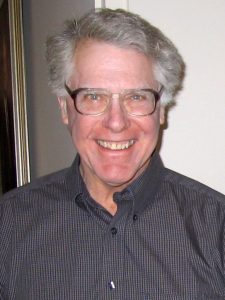Spotlight on Faculty – Elson, Elliot
 Stepping into Elliot Elson’s lab is like falling into the rabbit hole in Alice in Wonderland. There are movable amplifiers perched precariously on a sled of steel runners, lasers in black boxes, pieces of salvaged equipment, cords and cables spewing like spaghetti from another machine, and a huge black tent that looks like it was inspired by Darth Vader. This is a workshop for scientific invention. The tunnel burrows deeper into the natural world’s mysteries. The elusive White Rabbit entices us to follow and to probe the enigmas of life. Elliot Elson seeks to understand and characterize cells and tissues as physical entities. His “white rabbit” has led him to adventures and discoveries that have yielded new insights into the inner workings of life itself—in several different key fields.
Stepping into Elliot Elson’s lab is like falling into the rabbit hole in Alice in Wonderland. There are movable amplifiers perched precariously on a sled of steel runners, lasers in black boxes, pieces of salvaged equipment, cords and cables spewing like spaghetti from another machine, and a huge black tent that looks like it was inspired by Darth Vader. This is a workshop for scientific invention. The tunnel burrows deeper into the natural world’s mysteries. The elusive White Rabbit entices us to follow and to probe the enigmas of life. Elliot Elson seeks to understand and characterize cells and tissues as physical entities. His “white rabbit” has led him to adventures and discoveries that have yielded new insights into the inner workings of life itself—in several different key fields.
Dynamic Molecular Processes. As a new assistant professor at Cornell, Elliot and graduate student Robert Clegg collaborated with physics professor Bruce Maxfield to develop a rapid pressure perturbation kinetics instrument, which made it possible to look at chemical reactions in solution on a very fast time scale. This technology was later used to study protein folding in cytochrome c. During this time, in collaboration with Watt Webb and Doug Magde of the Cornell Physics Department, he also initiated studies of spontaneous concentration fluctuations and developed an elegant method for detecting molecular motion by passing a laser beam through a solution containing fluorescent molecules. When a molecule enters the beam, it fluoresces. A mathematical analysis of the resulting intensity record makes it possible to determine how many molecules are in the beam and how fast the molecules diffuse under specific conditions. This method, which they dubbed fluorescence correlation spectroscopy (FCS), was first used to study the physical chemistry of DNA. With enhancements in laser excitation, more sensitive photon detectors, and confocal microscope optics, FCS has become a widely-used method for studying the diffusion and reactions of molecules in solution and in living cells. Elliot went on to devise a related method, called fluorescence recovery after photobleaching (FRAP), for studying the dynamics of proteins on cell membranes and measuring diffusion of molecules on cell surfaces.
Mechanical Properties and Functions of Cells and Tissues. Elliot has also been fascinated by cellular mechanics—the mechanical properties of cells and the role of mechanics and other cellular forces on cell biological processes. To assess the stiffness and elasticity of single cells, he and colleagues Bill McConnaughey and Nils Petersen created the cell poker, which uses a tiny probe to indent living cells and measure the resisting force of the cell. To study the contraction of cells, for example cells that restore tissue integrity during wound healing, he and his team created an apparatus to sense the tension in a band of artificial tissue. In collaboration with Greg Goldberg (Medicine-Dermatology), he investigated a molecular motor called a collagenase that was the second molecular motor to be recognized after actin-myosin.
Tissue Engineering/Regenerative Biology. Elliot and his team are currently using stem cells to manufacture cardiac tissues. Working with Guy Genin from Mechanical Engineering and Materials Science, they have been putting cardiomyocytes into collagen tissues and studying their properties. The cells they use are either from chicken embryo hearts or from induced pluripotent stem cells that have been differentiated into a cardiac lineage. During the first 2-3 days in the tissue the heart cells make connections to each other and start beating synchronously.
How has Elliot accomplished these scientific advancements? “It’s from that incredible brain,” says Tony Pryse, who started out as Elliot’s graduate student at Cornell and has been collaborating with him and been a key member of his lab for more than three decades. “Few people have the breadth of knowledge and insight he has. He can talk to physicists who do the statistical physics of polymers. He can turn around and talk to cell biologists about biochemistry and the biology of cells. And he can talk to mechanical engineers about the constitutive equations of tissues. Personally, he just couldn’t be a better person to work for.” This thought is echoed by many of his colleagues and collaborators.
Phil Bayly, head of Mechanical Engineering and Materials Science and a long-time collaborator, shared this tribute: “I hate to use a cliché, but Elliot epitomizes the term ‘a scholar and a gentleman.’ He is a brilliant biophysicist who has contributed unique technical innovations, such as the cell poker, and fluorescence correlation spectroscopy, and used them to solve important problems involving the mechanics of cells and the extracellular environment. He is also a generous collaborator and mentor, who has advanced the careers of dozens of colleagues and students. He’s one of my favorite people at Washington University—and there are many others who feel the same way.”
Carl Frieden summarized his thoughts in his inimitably sage style:
How lucky can I be to have Elliot’s lab next door to mine.
Always available,
Always willing to help,
Always thoughtful,
Always insightful.
What a pleasure.
But in fact, it’s not just me,
All of Washington University is lucky to have Elliot here.
Thank you, Dr. Elson! We await your next scientific adventures.
